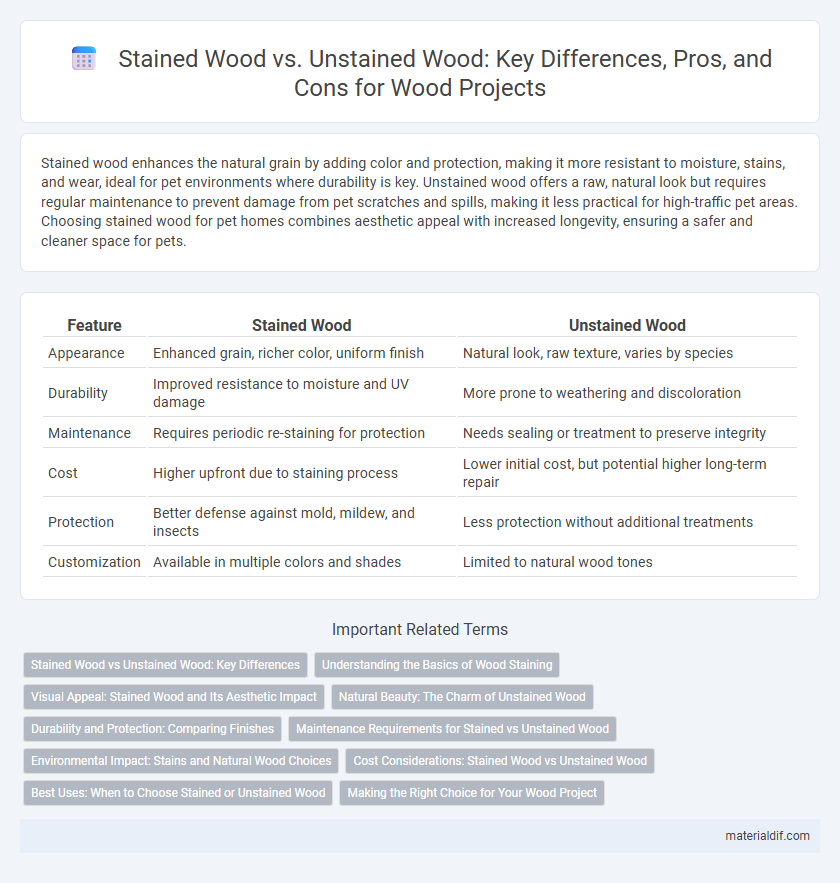Stained wood enhances the natural grain by adding color and protection, making it more resistant to moisture, stains, and wear, ideal for pet environments where durability is key. Unstained wood offers a raw, natural look but requires regular maintenance to prevent damage from pet scratches and spills, making it less practical for high-traffic pet areas. Choosing stained wood for pet homes combines aesthetic appeal with increased longevity, ensuring a safer and cleaner space for pets.
Table of Comparison
| Feature | Stained Wood | Unstained Wood |
|---|---|---|
| Appearance | Enhanced grain, richer color, uniform finish | Natural look, raw texture, varies by species |
| Durability | Improved resistance to moisture and UV damage | More prone to weathering and discoloration |
| Maintenance | Requires periodic re-staining for protection | Needs sealing or treatment to preserve integrity |
| Cost | Higher upfront due to staining process | Lower initial cost, but potential higher long-term repair |
| Protection | Better defense against mold, mildew, and insects | Less protection without additional treatments |
| Customization | Available in multiple colors and shades | Limited to natural wood tones |
Stained Wood vs Unstained Wood: Key Differences
Stained wood offers enhanced protection against moisture, UV damage, and wear, preserving the wood's durability and appearance over time. Unstained wood retains its natural look but is more susceptible to weathering, discoloration, and decay without protective coatings. The choice between stained and unstained wood impacts maintenance frequency, aesthetic appeal, and the wood's lifespan in various environmental conditions.
Understanding the Basics of Wood Staining
Wood staining enhances the natural grain and color of wood by penetrating its surface with pigmented oils or dyes, offering protection against moisture and UV damage. Unstained wood retains its original look but is more susceptible to wear, discoloration, and decay over time. Understanding wood stain types--oil-based, water-based, gel stains--and their effects on different wood species is essential for achieving desired aesthetic and durability outcomes.
Visual Appeal: Stained Wood and Its Aesthetic Impact
Stained wood enhances the natural grain by adding rich color tones, creating a more polished and sophisticated appearance compared to unstained wood's raw, natural look. The staining process deepens wood hues, increasing visual depth and warmth, which can complement various interior design styles. This aesthetic versatility makes stained wood a preferred choice for furniture and decorative applications seeking both beauty and durability.
Natural Beauty: The Charm of Unstained Wood
Unstained wood preserves the raw, authentic grain patterns and color variations, highlighting the natural beauty and unique character of each piece. This untreated surface allows wood to age gracefully, developing a rich patina that enhances its organic appeal. The absence of stain maintains the wood's breathability, preventing the masking of natural textures and promoting a more sustainable aesthetic.
Durability and Protection: Comparing Finishes
Stained wood offers enhanced durability and protection by penetrating the grain and forming a protective layer against moisture, UV rays, and wear, which helps prevent cracking and warping over time. Unstained wood lacks this protective barrier, making it more susceptible to damage from environmental factors and requiring more frequent maintenance to preserve its natural appearance. Choosing stained wood is ideal for outdoor applications or high-traffic areas where long-term resilience and reduced upkeep are essential.
Maintenance Requirements for Stained vs Unstained Wood
Stained wood offers enhanced protection against moisture, UV rays, and everyday wear, significantly reducing the frequency and intensity of maintenance compared to unstained wood. Unstained wood requires more frequent sealing or treatment to prevent cracking, warping, and discoloration caused by environmental exposure. Regular cleaning and reapplication of protective coatings are essential for both, but stained wood's built-in preservatives extend maintenance intervals and improve long-term durability.
Environmental Impact: Stains and Natural Wood Choices
Stained wood involves chemical treatments that can release volatile organic compounds (VOCs) and toxic substances during application and disposal, contributing to environmental pollution. Unstained wood, sourced sustainably and left untreated, reduces chemical usage and promotes biodegradability, minimizing ecological impact. Choosing natural, FSC-certified wood or reclaimed timber supports forest conservation and reduces carbon footprint compared to stained alternatives.
Cost Considerations: Stained Wood vs Unstained Wood
Stained wood typically requires a higher upfront investment due to the cost of stains and professional application, which enhances durability and aesthetic appeal. Unstained wood is less expensive initially but may incur additional costs over time for maintenance and protection against environmental damage. Budget-conscious projects often weigh the long-term expenses of staining against the cheaper initial price of unstained wood.
Best Uses: When to Choose Stained or Unstained Wood
Stained wood is ideal for outdoor furniture, flooring, and cabinetry where enhanced durability, color uniformity, and protection against moisture and UV damage are required. Unstained wood suits interior projects like raw shelving, rustic furniture, and crafts where a natural appearance and easy customization with paint or finish are preferred. Choose stained wood for long-term exposure and aesthetic consistency, while unstained wood works best for projects emphasizing natural texture and flexibility in finishing.
Making the Right Choice for Your Wood Project
Stained wood enhances the natural grain and color of the wood while providing protection against moisture and UV damage, making it ideal for outdoor projects or high-traffic areas. Unstained wood offers a pure, natural appearance and allows for easy customization with paint or natural finishes but requires more maintenance to prevent wear and deterioration. Choosing between stained and unstained wood depends on the desired aesthetic, durability needs, and exposure conditions of your specific woodworking project.
Stained Wood vs Unstained Wood Infographic

 materialdif.com
materialdif.com